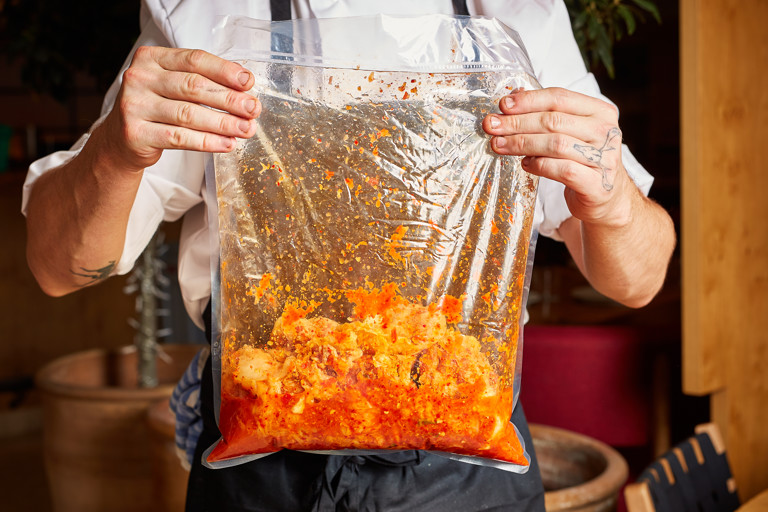Savoy cabbage kimchi
Item 1 of 1
There are a million different ways to prepare kimchi, Korea's famous preserved cabbage. In this recipe, chef Neil Campbell uses savoy cabbage instead of the more traditional napa cabbage, and omits the fish sauce to keep this kimchi vegan.
It's hard to say how much kimchi this will make, as it all depends on the size of your cabbages – however, once you're happy with the flavour keep it in the fridge and it will last for months.
First published in 2021
discover more:
Ingredients
Metric
Imperial
- 4 savoy cabbages
- 200g of garlic, peeled
- 200g of ginger, washed but unpeeled
- 200g of red chillies, deseeded
- 50g of gochugaru, (Korean red pepper flakes)
- salt, as needed
SAVE RECIPE
Method
1
Begin a week in advance, to allow the kimchi to ferment. Remove any discoloured or damaged large outer leaves from the cabbages
- 4 savoy cabbages
- salt, as needed
2
Weigh the remaining cabbages, then work out 2% of the weight – you will need this amount of salt to kickstart the fermentation process (e.g. 2kg of cabbage means you’ll need 40g of salt). Sprinkle the salt in between the leaves of the cabbages, gently scrunching, squeezing and rolling the cabbages as you work. Place them in a large bowl and set aside to sweat, sprinkling any remaining salt over the top. Leave for 30 minutes
3
Meanwhile, place the rest of the ingredients in a blender along with another 13g of salt and blitz into a paste
- 200g of garlic, peeled
- 200g of ginger, washed but unpeeled
- 200g of red chillies, deseeded
- 50g of gochugaru, (Korean red pepper flakes)
4
Once the cabbages have been salted for 30 minutes and look a bit sweaty, squeeze them once more (as if you’re wringing out a wet towel) to remove excess water. Make sure you have a clean, sterilised fermentation jar or vacuum bag ready
5
Place a cabbage in the base of the fermentation jar or bag, pulling it apart slightly if needed so it creates a flat layer. Spread a quarter of the ferment paste on top, then repeat with the rest of the cabbages, creating alternate layers of cabbage and ferment paste. The top layer should be ferment paste. If using a jar, push a sheet of cling film onto the top layer of paste to limit air exposure, then seal. If you're using a vacuum bag, compress and seal the kimchi using a vacuum machine
6
Leave at room temperature for at least 1 week, ‘burping’ the jar by opening and closing the lid each day to allow built-up gas to escape (there's no need to do this if you're using a bag, but it will probably inflate). Once you’re happy with the flavour, you can transfer the jar to the fridge to halt the fermentation process. If you have a PH meter, it should be below 3.5
Get in touch
Please sign in or register to send a comment to Great British Chefs.


